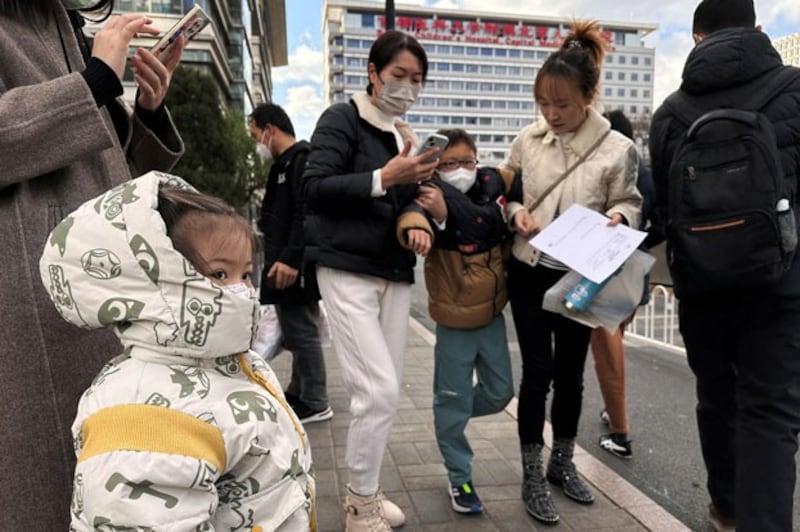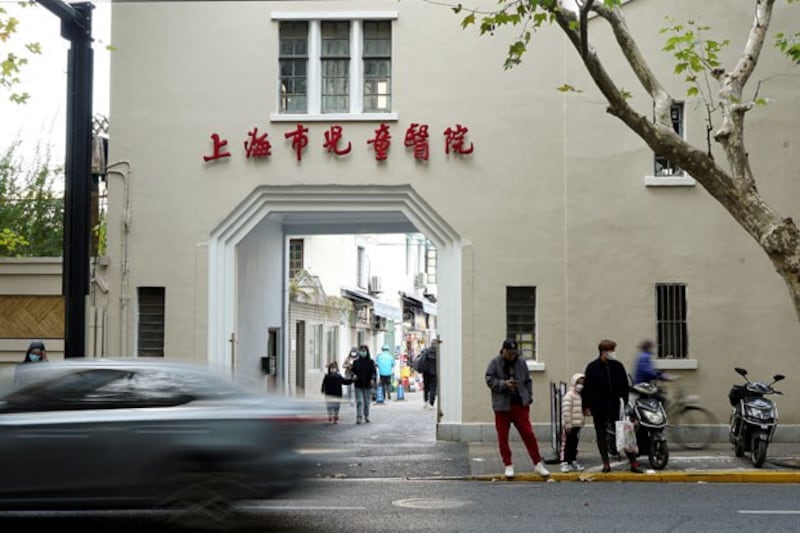A wave of respiratory infections that saw hospitals in northern China crowded with sick children last week has spread to the southern Chinese province of Guangdong, as officials sought to reassure the world that no new diseases have been detected.
Hospitals in Guangzhou, particularly pediatric outpatient clinics and children's hospitals, are full in many places, according to a report on the website of state-run China National Radio.
"[We] visited a number of medical facilities in Guangzhou, and found that Mycoplasma pneumoniae, influenza, respiratory syncytial virus and other pathogens have been co-circulating recently," the report said.
"The number of children infected with respiratory diseases has increased, and patients are crowding into pediatric and maternal health facilities," it said.

Meanwhile, a copy of a notice suspending some classes at the Wanjiang No. 2 Primary School in Guangdong's Dongguan city for four days was posted to X on Tuesday.
"Due to illness among students in class 108, mostly flu and fever, affecting a third of the class, following suggestions and requirements from the Wanjiang Center for Disease Control and Prevention, Class 108 will close for four days," the notice said.
"Class will resume next Monday or Tuesday," it said.
"This pneumonia wave has already spread to the south," current affairs commentator Ji Feng told Radio Free Asia. "Guangzhou Children's Hospital is overcrowded."
"That primary school in Dongguan had to close because one third of a class got sick," he said, adding that not much information about the outbreak has been made public by local authorities.
A person connected with the school who declined to be named said students aren't allowed to go back to class until they get a certificate of recovery from the hospital.
"Hospitals are overcrowded right now, and a lot of outpatient clinics have been turned into fever clinics," the person said. "A lot of students are absent from school every day."
"We don't know if it's mycoplasma because they won't tell us clearly [what is happening]," the person said. "We're confused and we don't know."
WHO calls for data
The news emerged as the World Health Organization called on Beijing to share its data on an outbreak in Beijing and Tianjin that made international headlines last week.
Chinese health authorities said they haven't detected any new or unusual bugs and provided the requested data on an increase in respiratory illnesses and reported clusters of pneumonia in children, the World Health Organization said last week.
"The National Health Commission and the National Administration of Disease Prevention and Control, at the request of the WHO, has arranged for exchanges between experts and the WHO on the recent situation of respiratory infectious diseases," foreign ministry spokesperson Wang Wenbin told a news briefing in Beijing on Tuesday.
"Let me assure you that it is safe to travel and do business here in China and there’s no need to worry," Wang said.
The WHO request came after the Program for Monitoring Emerging Diseases (ProMED) reported clusters of "undiagnosed pneumonia" in children in north China.
According to Chinese officials, influenza, respiratory syncytial virus and adenovirus have been in circulation since October, while "no unusual pathogens have been detected in the capital of Beijing and the northeastern province of Liaoning," Reuters reported.

Reports have also emerged on local media and social media platforms of the reappearance of white-clad disease control officers, who were last seen enforcing mass quarantines, lockdowns and compulsory testing during the three years of ruling Chinese Communist Party leader Xi Jinping's zero-COVID policy, which ended in December 2022 following nationwide protests.
Repeated calls to children's hospitals in Beijing and Tianjin returned only busy signals during office hours on Tuesday.
An employee who answered the phone at the Dalian Children's Hospital in the northeastern province of Liaoning said it was no longer possible to register a patient online or to make an appointment, and that pneumonia patients are being treated in "emergency mode" now.
They declined to say what was causing the wave of pneumonia cases, although a number of experts have been quoted in Chinese media reports as saying it is partly due to mycoplasma pneumonia.
"Pneumonia cases can only register in person at our emergency room, and in most cases we have to administer a drip," the staff member said.
Repeated calls to the cell phone of respiratory disease specialist Zhong Nanshan rang unanswered on Tuesday.
Wave of respiratory infections
National Health Commission spokesperson Mi Feng told a news conference in Beijing on Sunday that there is a wave of respiratory infections in China caused by various pathogens including rhinovirus, Mycoplasma pneumoniae, respiratory syncytial virus and adenovirus.
Some experts have blamed post-lockdown waves of infections on "immunity debt," while others say this is a " dangerous and misguided concept" that plays into narratives that childhood diseases should be allowed to run their course without public health interventions.
The outbreak follows the mass infection and reinfection of China's population with the Omicron variant of COVID-19 immediately following the lifting of nationwide zero-COVID restrictions in December 2022.
Some recent medical research has pointed to weakened immunity from infection and reinfection with COVID-19, which has also been linked to recent surges in respiratory infections in children.
Translated by Luisetta Mudie .

